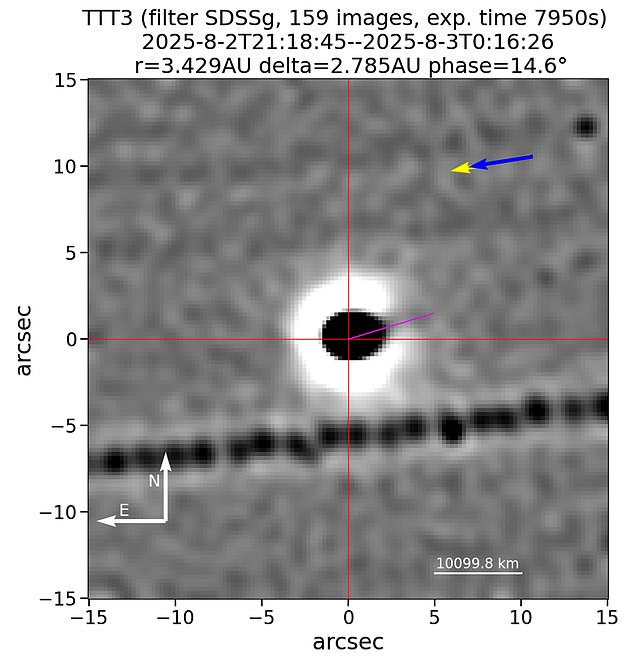The interstellar visitor 3I/ATLAS has displayed behavior never before seen in a comet.
In August, the Two-Meter Twin Telescope in the Canary Islands captured an image showing a faint jet extending roughly 3.7 miles from the object’s nucleus, pointing toward the sun.
This stream of gas and dust is unusual because comet tails are typically pushed away from the Sun by solar radiation and wind.
Harvard professor Avi Loeb said on Friday: ‘The existence of an anti-tail pointed toward the sun is an anomaly that raises two questions: What is the nature of the anti-tail?
‘Why are comet experts ignoring this anomaly while insisting that 3I/ATLAS is a familiar comet?’
Weeks earlier, the Hubble Space Telescope observed a similar phenomenon, capturing an extended glow aimed sunward in late July.
Loeb explained that the glow stretched roughly ten times longer than it was wide, forming what he described as the geometry of a jet directed at the Sun, a pattern unlike any known comet.
‘Realizing this is as shocking as photographing an animal your family thinks is a street cat, only to see a tail coming out of its forehead,’ Loeb said.

In August, the Two-Meter Twin Telescope in the Canary Islands captured an image showing a faint jet extending roughly 3.7 miles from the object’s nucleus, pointing toward the sun
He noted that while many specialists hailed the Hubble image as evidence that 3I/ATLAS behaves like a comet, they overlooked the critical detail: the jet points the wrong way.
Both the Hubble and ground-based observations show material moving toward the Sun, contradicting the physics that normally shape comet tails.
Loeb suggests the unusual orientation could indicate the object is ejecting large, heavy particles less affected by sunlight, or that an entirely new type of outgassing mechanism may be at work.
The professor has speculated that 3I/ATLAS could be of extraterrestrial origin, the moment it was identified in July.
Loeb said there is a 30 to 40 percent chance the object ‘does not have a fully natural origin,’ noting the possibility it is a ‘Trojan Horse,’ where a technological object masquerades as a comet.
However, the world could soon know the answer when 3I/ATLAS makes its closest approach to the sun on October 29.
The object should ‘disintegrate into fragments’ if it is a comet.
‘When a comet gets close to the sun, solar radiation heats its icy nucleus,’ Loeb explained.

Comet 3I/ATLAS streaks across a dense star field in this image captured by a telescope in Chile
‘Volatile ices like carbon dioxide, carbon monoxide, or water sublimate directly into gas, carrying away dust and small rocks.
‘This process can cause the comet to break apart if the mix of ice and dust cannot withstand the thermal stress.’
The European Space Agency’s Jupiter probe will have a front-row seat, capturing the moment it either breaks apart or, as Loeb speculated, ‘releases mini-probes as a technological mothership.’
The ESA’s Jupiter Icy Moons Explorer (Juice) craft will have a view of the object when it comes 125 million miles from the planet and monitor it through November.
‘During November and December, terrestrial observatories will also be able to monitor 3I/ATLAS and check whether it disintegrated like a natural comet or released mini-probes as a technological mothership,’ Loeb explained.
While the professor believes there is a possibility it is of alien origin, NASA has long said the object is a natural comet.
The American space agency released images of 3I/ATLAS as it soared past Mars on October 3, showing it as cylindrical-shaped.
Stargazers on social media shared color-enhanced images of the object, which showed the interstellar visitor having a green glow.
Loeb and many other scientists are anticipating the visitor’s journey to the sun as it will finally put the mystery to rest.
3I/ATLAS will appear as a fuzzy ball of light in the blackness of space, and if it does disintegrate, the professor said it will break into independent, smaller dots of light.
This article was originally published by a www.dailymail.co.uk . Read the Original article here. .

